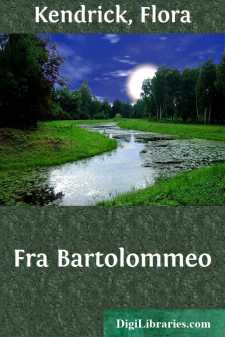Categories
- Antiques & Collectibles 13
- Architecture 36
- Art 48
- Bibles 22
- Biography & Autobiography 813
- Body, Mind & Spirit 142
- Business & Economics 28
- Children's Books 17
- Children's Fiction 14
- Computers 4
- Cooking 94
- Crafts & Hobbies 4
- Drama 346
- Education 46
- Family & Relationships 57
- Fiction 11829
- Games 19
- Gardening 17
- Health & Fitness 34
- History 1377
- House & Home 1
- Humor 147
- Juvenile Fiction 1873
- Juvenile Nonfiction 202
- Language Arts & Disciplines 88
- Law 16
- Literary Collections 686
- Literary Criticism 179
- Mathematics 13
- Medical 41
- Music 40
- Nature 179
- Non-Classifiable 1768
- Performing Arts 7
- Periodicals 1453
- Philosophy 64
- Photography 2
- Poetry 896
- Political Science 203
- Psychology 42
- Reference 154
- Religion 513
- Science 126
- Self-Help 84
- Social Science 81
- Sports & Recreation 34
- Study Aids 3
- Technology & Engineering 59
- Transportation 23
- Travel 463
- True Crime 29
Fra Bartolommeo
by: Flora Kendrick
Categories:
Description:
Excerpt
CHAPTER I.
THOUGHTS ON THE RENAISSANCE.
It seems to be a law of nature that progress, as well as time, should be marked by periods of alternate light and darkness—day and night.
This law is nowhere more apparent than in the history of Art. Three times has the world been illuminated by the full brilliance of Art, and three times has a corresponding period of darkness ensued.
The first day dawned in Egypt and Assyria, and its works lie buried in the tombs of prehistoric Pharaohs and Ninevite kings. The second day the sun rose on the shores of many-isled Greece, and shed its rays over Etruria and Rome, and ere it set, temples and palaces were flooded with beauty. The gods had taken human form, and were come to dwell with men.
The third day arising in Italy, lit up the whole western world with the glow of colour and fervour, and its fading rays light us yet.
The first period was that of mythic art; the world like a child wondering at all around tried to express in myths the truths it could not comprehend.
The second was pagan art which satisfies itself that in expressing the perfection of humanity, it unfolds divinity. The third era of Christian art, conscious that the divine lies beyond the human, fails in aspiring to express infinitude.
Tracing one of these periods from its rise, how truly this similitude of the dawn of day is carried out. See at the first streak of light how dim, stiff, and soulless all things appear! Trees and objects bear precisely the relation to their own appearance in broad daylight as the wooden Madonnas of the Byzantine school do to those of Raphael.
Next, when the sun—the true light—first appears, how it bathes the sea and the hills in an ethereal glory not their own! What fair liquid tints of blue, and rose, and glorious gold! This period which, in art, began with Giotto and ended with Botticelli, culminated in Fra Angelico, who flooded the world of painting with a heavenly spiritualism not material, and gave his dreams of heaven the colours of the first pure rays of sunshine.
But as the sun rises, nature takes her real tints gradually. We see every thing in its own colour; the gold and the rose has faded away with the truer light, and a stern realism takes its place. The human form must be expressed, in all its solidity and truth, not only in its outward semblance, but the hidden soul must be seen through the veil of flesh. And in this lies the reason of the decline; only to a few great masters it was given to reveal spirituality in humanity—the others could only emulate form and colour, and failed.
It is impossible to contemplate art apart from religion; as truly as the celestial sun is the revealer of form, so surely is the heavenly light of religion the first inspirer of art.
Where would the Egyptian, Assyrian, and Etruscan paintings and sculptures have been but for the veneration of the mystic gods of the dead, which both prompted and preserved them?
What would Greek sculpture have been without the deified personifications of the mysterious powers of nature which inspired it?...


